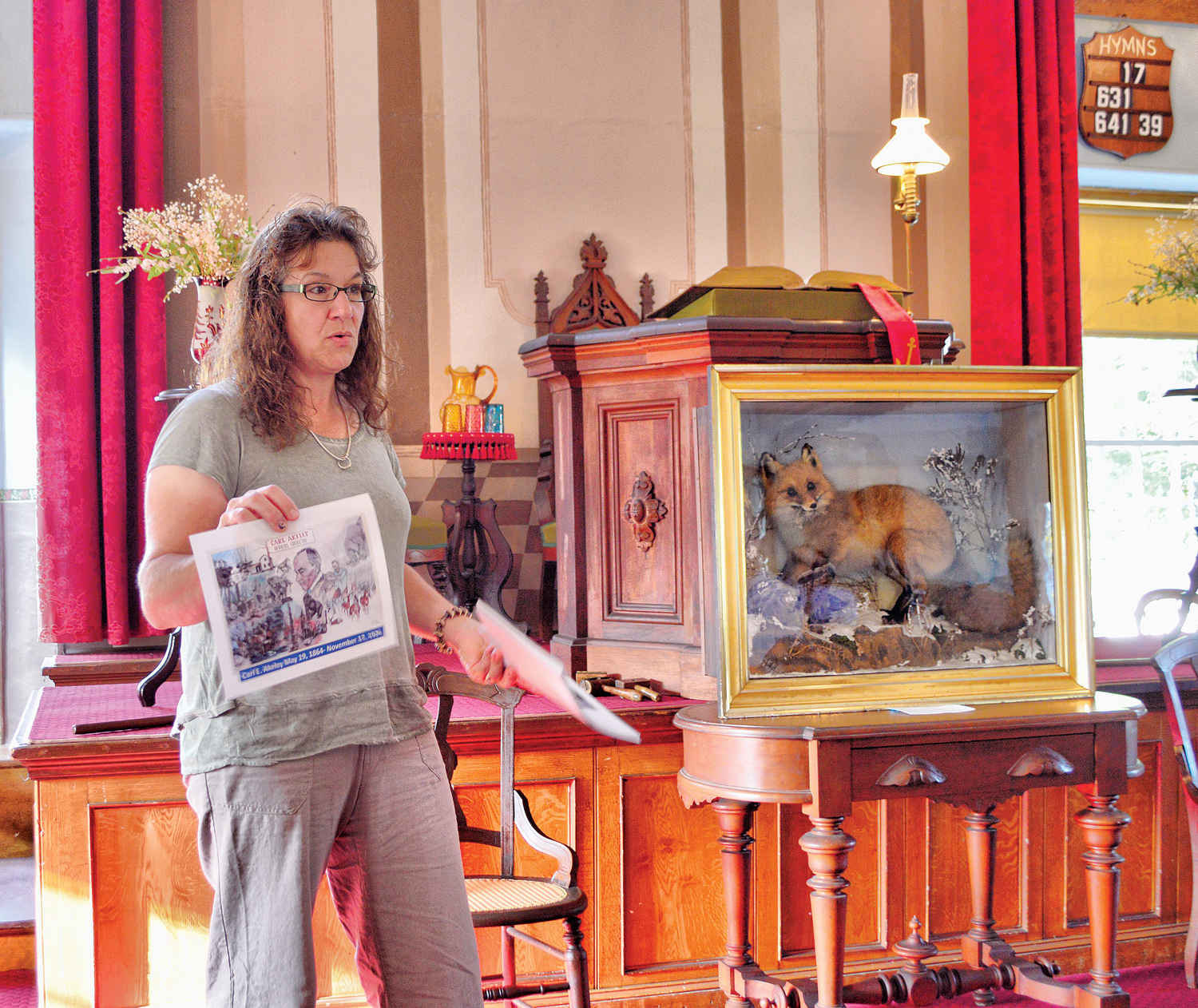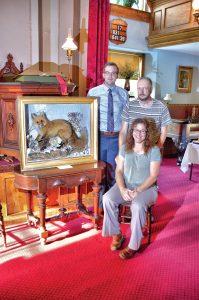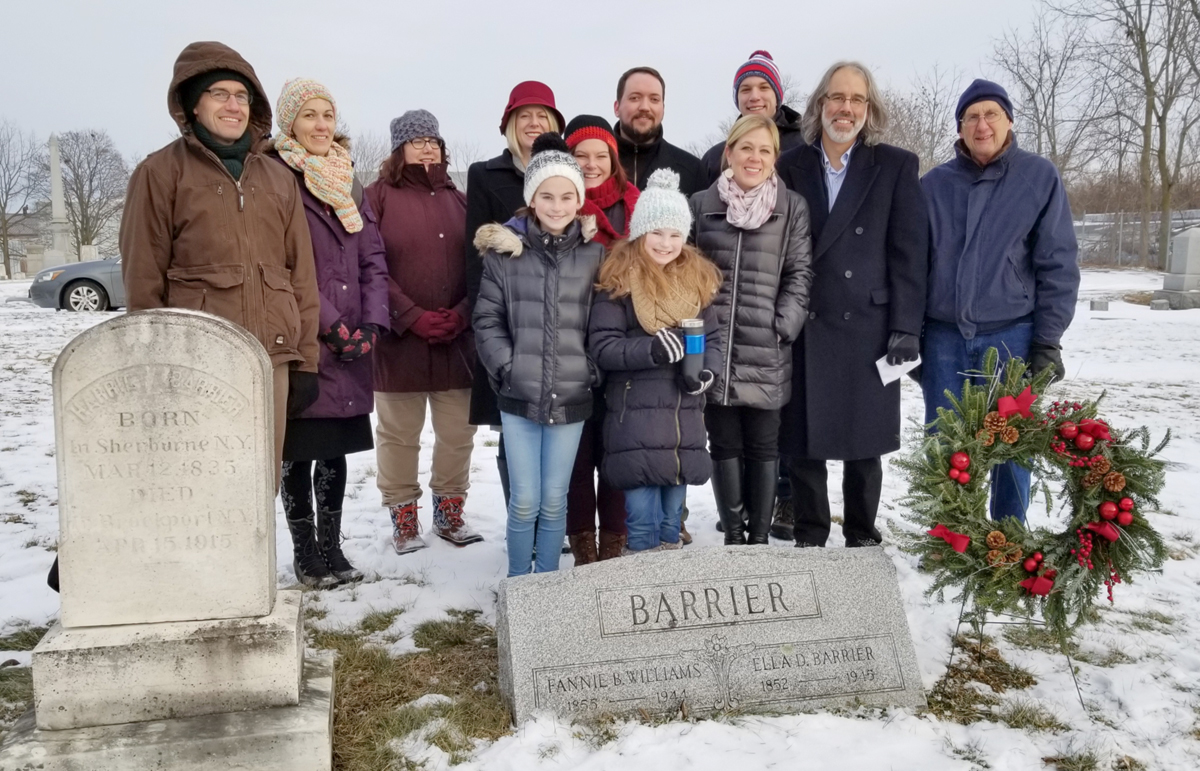Akeley Fox welcomed back to Cobblestone Museum

A rare example of the early work of famed Clarendon taxidermist/artist/inventor Carl Akeley, was welcomed back to the Cobblestone Museum in Childs, Orleans County, during a special reception Saturday, September 16.
Part of the museum collection, a red fox mounted by Akeley in 1879 when he was 16 years old, was recently restored and returned to the museum in what Cobblestone Museum director Doug Farley said was a “world-class effort.”
The September 16 reception included talks by Farley, retired Orleans County historian and Cobblestone Museum director Bill Lattin, Orleans County historian Matthew Ballard and Clarendon historian Melissa Ierlan.
The fox – along with a golden eagle which is part of the collection of the Emily L. Knapp Museum in Brockport – were taken to George Dante at Wildlife Preservation/Natural History Exhibit Services in New Jersey. Dante worked with two conservators from the American Museum of Natural History to restore the Akeley fox.
The fox was in very poor shape. One of the glass eyes had fallen out, the tail had “melted,” the paws were void of hair, and bugs had also done damage, Orleans County historian Matthew Ballard said.

“We thought we would have to replace it,” Clarendon historian Melissa Ierlan said of the fox, “but we didn’t.” George Dante had to replace the tail, but simply vacuuming the fox’s coat began to bring the more than 130-year old mount back to life, she said
Ierlan described Akeley as the original, “Indiana Jones … they could make a movie about all the things he did,” she said. Akeley is known as the father of modern taxidermy for his work to make his museum mounts lifelike. Akeley stretched the animal hide over a sculpted form, which included the animal’s musculature, and set his mounts in their natural habitats. He created the Hall of African Mammals at the American Museum of Natural History in New York City.
Akeley was also an accomplished sculptor, conservationist, biologist and inventor. He devised improvements for motion picture cameras to capture movement of animals in nature and is also credited with inventing shotcrete.
Akeley was one of “America’s greatest men,” Ierlan said. He was born in 1864 on Hinds Road in Clarendon and studied taxidermy with David Bruce in Brockport. He later had an apprenticeship in taxidermy at Ward’s Natural Science Establishment in Rochester.
Akeley made many safari trips to Africa to gather specimens for his exhibits and died there in 1926. Akeley is buried in Africa.
Retired Orleans County historian Bill Lattin has a personal connection to the Akeley fox; his great-grandfather, Francis Harling, procured the fox for Akeley to mount for the Harling family home in Albion. Lattin said the Akeley fox is, “very, very special … in the world of taxidermy, it’s like owning a Rafael. It is now fully restored and looking as it would have when Akeley finished it.” Lattin also noted that the mounted fox helps people today to appreciate what our ancestors saw as beautiful. “He went out of his way to procure this fox,” Lattin said of his great-grandfather, “there isn’t that kind of appreciation today.”
Orleans County Historian Matthew Ballard called the fox stunning and a, “piece of national significance.” He explained that following a visit to Clarendon in 2014 for a 150th anniversary celebration of Akeley’s birth, Carl Akeley expert John Janelli and Jay Kirk, author of Kingdom Under Glass about Akeley’s life and work, expressed the importance of having the fox mount restored as an example of Akeley’s early work.
The challenge was finding funding for the project.
Several private donations were made and the project received grant funds from the Elizabeth Dye Curtis Foundation as well as a donation from the Daughters of the American Revolution Orleans Chapter.
Cobblestone Museum officials said the fox mount can be viewed by visitors on the lower level of the Cobblestone Church located at 14389 Ridge Road (Route 104) in Childs, just east of the intersection of Route 98.




